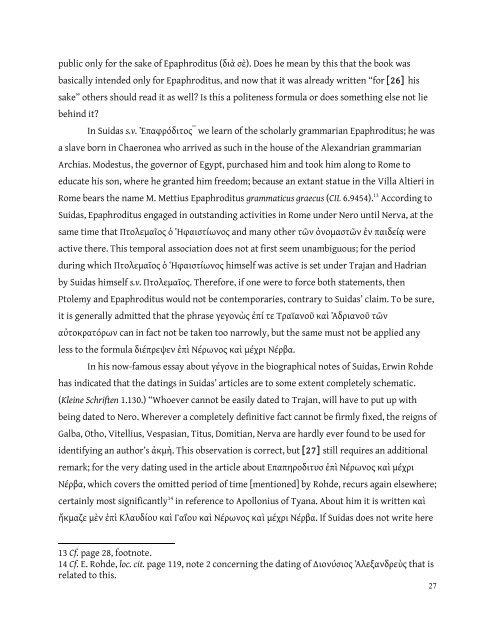The Jewish Historian Flavius Josephus: A Biographical Investigation
The Jewish Historian Flavius Josephus: A Biographical Investigation
The Jewish Historian Flavius Josephus: A Biographical Investigation
You also want an ePaper? Increase the reach of your titles
YUMPU automatically turns print PDFs into web optimized ePapers that Google loves.
public only for the sake of Epaphroditus (διὰ σὲ). Does he mean by this that the book was<br />
basically intended only for Epaphroditus, and now that it was already written “for [26] his<br />
sake” others should read it as well? Is this a politeness formula or does something else not lie<br />
behind it?<br />
In Suidas s.v. Ἐπαφρόδιτος῎῍ we learn of the scholarly grammarian Epaphroditus; he was<br />
a slave born in Chaeronea who arrived as such in the house of the Alexandrian grammarian<br />
Archias. Modestus, the governor of Egypt, purchased him and took him along to Rome to<br />
educate his son, where he granted him freedom; because an extant statue in the Villa Altieri in<br />
Rome bears the name M. Mettius Epaphroditus grammaticus graecus (CIL 6.9454). 13 According to<br />
Suidas, Epaphroditus engaged in outstanding activities in Rome under Nero until Nerva, at the<br />
same time that Πτολεμαῖος ὁ Ἡφαιστίωνος and many other τῶν ὀνομαστῶν ἐν παιδείᾳ were<br />
active there. This temporal association does not at first seem unambiguous; for the period<br />
during which Πτολεμαῖος ὁ Ἡφαιστίωνος himself was active is set under Trajan and Hadrian<br />
by Suidas himself s.v. Πτολεμαῖος. <strong>The</strong>refore, if one were to force both statements, then<br />
Ptolemy and Epaphroditus would not be contemporaries, contrary to Suidas’ claim. To be sure,<br />
it is generally admitted that the phrase γεγονὼς ἐπί τε Τραϊανοῦ καὶ Ἁδριανοῦ τῶν<br />
αὐτοκρατόρων can in fact not be taken too narrowly, but the same must not be applied any<br />
less to the formula διέπρεψεν ἐπὶ Νέρωνος καὶ μέχρι Νέρβα.<br />
In his now-famous essay about γέγονε in the biographical notes of Suidas, Erwin Rohde<br />
has indicated that the datings in Suidas’ articles are to some extent completely schematic.<br />
(Kleine Schriften 1.130.) “Whoever cannot be easily dated to Trajan, will have to put up with<br />
being dated to Nero. Wherever a completely definitive fact cannot be firmly fixed, the reigns of<br />
Galba, Otho, Vitellius, Vespasian, Titus, Domitian, Nerva are hardly ever found to be used for<br />
identifying an author’s ἀκμὴ. This observation is correct, but [27] still requires an additional<br />
remark; for the very dating used in the article about Επαπηροδιτυσ ἐπὶ Νέρωνος καὶ μέχρι<br />
Νέρβα, which covers the omitted period of time [mentioned] by Rohde, recurs again elsewhere;<br />
certainly most significantly 14 in reference to Apollonius of Tyana. About him it is written καὶ<br />
ἤκμαζε μὲν ἐπὶ Κλαυδίου καὶ Γαΐου καὶ Νέρωνος καὶ μέχρι Νέρβα. If Suidas does not write here<br />
13 Cf. page 28, footnote.<br />
14 Cf. E. Rohde, loc. cit. page 119, note 2 concerning the dating of Διονύσιος Ἀλεξανδρεὺς that is<br />
related to this.<br />
27
















